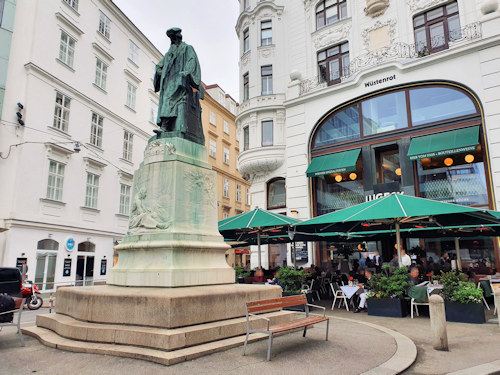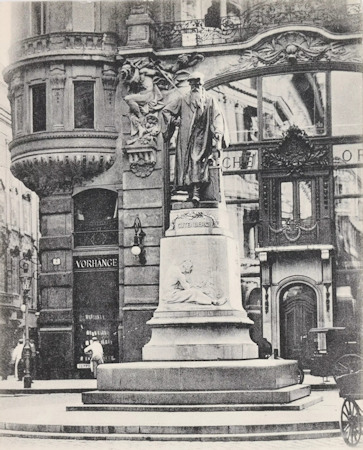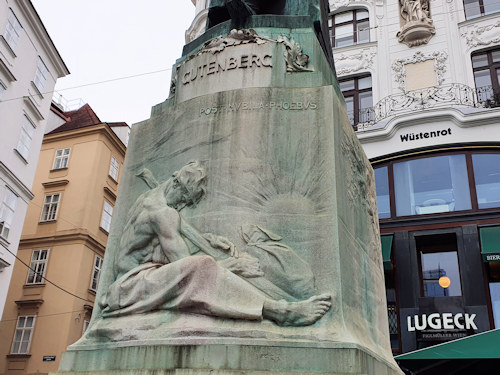
The unassuming chap in a floppy cap on Lugeck square turns out to be one of Europe’s most pivotal characters. The statue and monument pays tribute to Johannes Gutenberg.
- Erected in 1900 in honour of the pioneer of the printing press
- Reliefs represent the change made possible by Gutenberg
- Emperor Franz Joseph took part in the unveiling
- See also:
Johannes Gutenberg statue

(Johannes stands guard over Restaurant Lugeck)
A long list of historical celebrities have an association with Vienna, and many also have a statue, plaque or street name to honour the connection.
But the city likes to pay its respects to a few folk who probably never set foot inside the city walls.
One example is a monument to Johannes Gutenberg (ca. 1400 – 1468), who introduced the moving type printing press to Europe. His efforts proved a milestone in history and catalysed a whole range of crucial cultural, scientific and socioeconomic developments.
The Austrian National Library in Vienna actually owns one of the very few complete bibles printed by Gutenberg. Just pop along with your library card and you might be able to borrow it. Or possibly not.
Another tenuous Vienna connection is Frederick III. He was the first Habsburg Holy Roman Emperor (from 1452 to 1493) and lies buried in Stephansdom cathedral.
At the start of Frederick’s reign, Gutenberg lived in the Electorate of Mainz (in modern-day Germany), which was then part of the Holy Roman Empire. (I told you the connection was tenuous.)

(The memorial shortly after its unveiling, produced in 1901 by Stengel & Co., Dresden; Wien Museum Inv.-Nr. 182911; excerpt reproduced with permission under the terms of the CC0 licence)
Anyway, the monument rests on the small Lugeck square just down the road from Stephansdom. The area is best known for its culinary delights, such as those offered by Zanoni & Zanoni (a popular ice cream parlour) or Restaurant Lugeck (run by the Figlmüller Group of schnitzel fame).
The Gutenberg monument went up in 1900 (so roughly 500 years after Gutenberg’s birth), thanks to the efforts of a private fundraising committee. The unveiling took place on December 17th in the presence of both Emperor Franz Joseph and the then mayor of Vienna.
The monument features a figurative statue of a bearded Gutenberg. He stands on a raised plinth, one hand on his hip.
That plinth includes the Latin phrase, Post Nubila Phoebus, meaning “after the clouds, comes the sun.” This hints at the impact of Gutenberg’s invention on European culture. The reliefs add further imagery to this sentiment:
- A broken column as a symbol for the dark ages
- A sleeping wanderer as a symbol for humanity
- A laurel tree symbolising success and fame

(This relief symbolises humanity)
The rear of the pedestal has the printer coat of arms and a dedication (my translation):
To the grand master from his grateful followers and admirers
Hans Bitterlich (1860 – 1949) took 2 1/2 years to make the bronze Gutenberg statue. A noted sculptor of his time, Bitterlich contributed many works to the Viennese cityscape, including the memorial to Empress Elisabeth in the Volksgarten park.
The plinth with its reliefs was by the architect Max Fabiani (1865 – 1962), a colleague of Otto Wagner. Fabiani enjoys enduring fame through his design for the Urania building that marks the eastern corner of the city centre, where the River Wien meets the Danube canal.
How to get to Gutenberg
Lugeck could hardly be more central.
Subway: the square sits between the Stephansplatz (U1 and U3 lines) and Schwedenplatz (U1 and U4 lines) stations
Tram/bus: take the 1 or 2 tram to Schwedenplatz and walk up or jump on the 2A bus to the Rotenturmstraße stop at the edge of the square
Address: Lugeck 4, 1010 Vienna